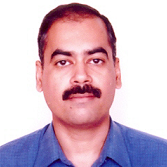
Rajoo Pandey
Work place: Department of Electronics and Communication Engineering National Institute of Technology Kurukshetra, 136119, Haryana, India
E-mail: rajoo_pandey@nitkkr.ac.in
Website:
Research Interests: Computer systems and computational processes, Neural Networks, Image Manipulation, Image Processing
Biography
Rajoo Pandey received the B.E., M.Tech., and Ph.D. degrees in Electronics and Communication Engineering in 1989, 1991, and 2001 from Government Engineering College, Jabalpur, R.E.C. Kurukshetra, and Indian Institute of Technology, Roorkee, India, respectively. He is Professor and at present Head in the Department of Electronics and Communication Engineering, N.I.T. Kurukshetra, India. His research interests include signal and image processing and communication system.
Author Articles
Segment-wise Quality Evaluation for Identification of Face Spoofing
By Akhilesh Kumar Pandey Rajoo Pandey
DOI: https://doi.org/10.5815/ijigsp.2020.01.04, Pub. Date: 8 Feb. 2020
Non-intrusive nature of the face-based recognition technology makes it more popular among hand held devices. Spoof detection in face-based recognition systems has been an important topic of the research in the last decade. Among several techniques available in the literature for liveness detection, image quality measure (IQM) based technique are particularly attractive due to their computational efficiency. In this paper, an approach based on segment-wise computation of image quality measures is proposed to improve the accuracy of detection. Two types of the non-overlapping segments are considered here: 1) rectangular segments of identical sizes, 2) segment based on neighborhood variance. It is found that both approaches exhibit better performance in comparison with other techniques without increasing too much computational complexity. The experiments are carried out with well-known Replay-Attack database to prove its robustness under different conditions.
[...] Read more.An Improved Energy Aware Distributed Clustering Protocol for Wireless Sensor Networks
DOI: https://doi.org/10.5815/ijcnis.2016.06.04, Pub. Date: 8 Jun. 2016
The present work considers energy aware distributed clustering protocol (EADC) which is commonly employed for balancing the energy consumption in non-uniformly deployed sensor networks. In the EADC, residual energy is considered as the primary clustering parameter and the clusters are constructed using uniform competition radius. However in non-uniform node distribution scenarios, more energy imbalance occurs in the network due to variation in intra-cluster energy consumption. For counter balancing it, an inter-cluster energy-efficient multi-hop routing protocol is utilized. In the EADC protocol, cluster heads select the relay node based on residual energy and cluster member count information. But this approach is less efficient in energy balancing. In this paper, an improved energy aware distributed equal clustering protocol is projected. Our scheme considers the relay metric directly in terms of energy expense in relaying the sensed data to the base station taking into account not only the residual energy and member count information but also distance information. It provides better balancing of energy in comparison with the existing approach. Three different scenarios created by varying node distribution are used for evaluating the performance of the proposed protocol and comparison is made with the EADC protocol. The results show that the proposed scheme extends network lifetime in all the scenarios.
[...] Read more.Modified LEACH-DT Algorithm with Hierarchical Extension for Wireless Sensor Networks
DOI: https://doi.org/10.5815/ijcnis.2016.02.04, Pub. Date: 8 Feb. 2016
The selection of cluster heads is of immense importance in the cluster based protocols which are widely used in wireless sensor networks. However, for the random selection of cluster heads when the distance of cluster heads is also taken into account such as in LEACH-DT algorithm, the lifetime of the network is improved. In this paper, a new algorithm for selection of cluster heads is proposed where the residual energy of the cluster heads is also considered along with the distance to the base station. The proposed approach ensures better energy balance of the network nodes. The performance of the proposed algorithm is measured at various stages of network lifetime and a significant improvement over LEACH-DT has been observed. Also, a two-level heterogeneous hierarchical architecture of the proposed algorithm is investigated which further enhances the performance of the proposed algorithm.
[...] Read more.Other Articles
Subscribe to receive issue release notifications and newsletters from MECS Press journals